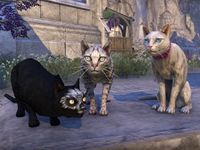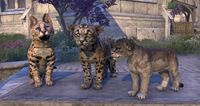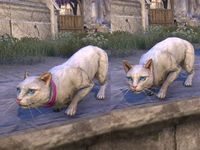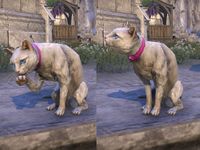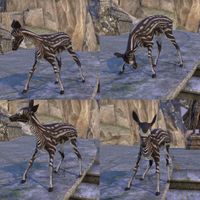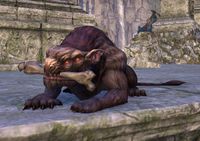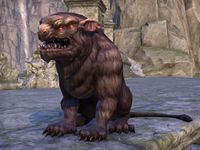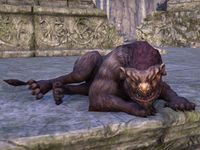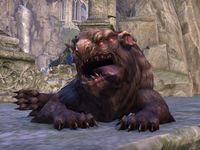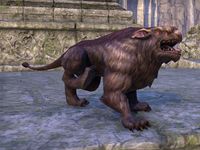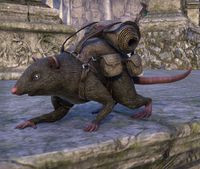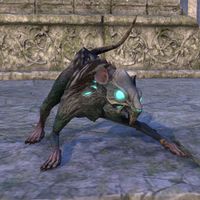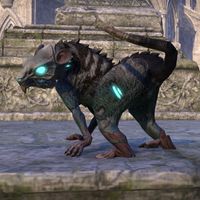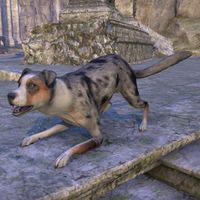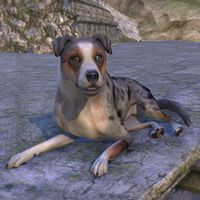User:MolagBallet/Sandbox 10
((end of the main body paragraph here)
Different kinds of pets can perform different animations. For a comprehensive guide on all the cute things your little companions can do, see the appropriate section.
Below is a list of available noncombat pets: (big pet TOC here, newline at the bottom)
Contents
Animations[edit]
Felines[edit]
Felines encompass cats of all kinds: domestic cats, kittens, senche cubs, you name it. Feline pets share most of the same kinds of animations. There are different types of feline pets, and some subtypes have animations unique to their mesh group.
Cats can make several different kinds of noises. They can purr, hiss, meow, chirp (a small, quiet throaty "meow-like" sound; kind of like a "mrrp") and trill.
Many animations are shared between modern cat meshes. The basic cat animations (which all cats have unless stated otherwise) are as follows:
- Idle Animation 1
- The cat looks from side to side while its ears and tail twitch.
- Idle Animation 2
- Cats can wiggle their ears and stretch their jaws while lifting their heads. The cat will shake its head when it's done stretching its jaw. This animation occurs while standing, and the cat will often smoothly transition from the first idle animation to this one.
- Attempting to catch a butterfly
- A butterfly flies into view. The cat looks up at it, gets down on its haunches, pounces, and falls onto its back with the butterfly in its front paws. It rolls around, biting and kicking with its hind legs, then loses the butterfly. The cat rolls over onto its stomach, shakes its head, then returns to an idle position.
- Stretch
- The cat briefly looks down at its paws before getting down on its haunches and stretching, putting its forelegs out in front of itself and curling its tail upwards. When it's done stretching out the back half, the cat pulls itself forward, using its front paws for leverage and raising the front half of its body forward. Its tail swishes back and forth, and the cat puts its legs back into a position where they're reasonably positioned near each other. The cat looks off to the left, then shakes its head and returns to an idle position.
- Impromptu butterfly visit
- The cat sits down. A butterfly flits down from the right, and the cat does a double take as it notices the insect. When it finally stares right at the bug, the cat leans in the opposite direction as if it were taken aback. It leans forward, raising a paw about elbow-height as it moves its head towards the insect to get a look at it. The cat's tail twitches as it stares inquisitively at its quarry. The butterfly lands on the cat's nose, surprising the pet. The cat then shakes its head, and the butterfly flies off. The cat tilts its head up to watch the bug fly away, then stands back up and returns to its idle pose.
- Grooming distraction
- The cat sits down and meows, opening its mouth. It then crouches down as if hunting or preparing for a playful pounce, swishing its tail at an increasingly swift pace. Then, it looks down at its front right leg and begins licking it.
Big-Eared Cats[edit]
These short-haired cats have very large ears and slender limbs. The Mages Guild Sentry Cat and Big-Eared Ginger Mouser are examples of big-eared cats.
The Big-Eared Ginger Kitten, a smaller version of the ginger mouser with a goofier ear-to-head ratio, has a unique animation all to itself: it rarely plays with a phantasmal ball of yarn that materializes out of thin air.
- Simple Sit
- The cat sits down and looks around for a few seconds.
- Lie down
- The cat lays down, partially leaning on one side. The cat looks lazily from side to side, and stands back up after approximately eight seconds.
Sphynx[edit]
Sphynx cats are either hairless or have incredibly short, fine hair. They are particularly expressive, as they have large eyes. You can see the surprise in their eyes during the impromptu butterfly visit animation! There are currently two Sphynx cats: Tu'whacca's Sphynx Cat and the Sphnx Lynx.
- Cat scratch
- The cat rears up on its hind legs and brings them down, lunging forward and swiping with both of its front paws as it hisses.
- Shiver
- The cat bends its knees slightly, stiffening and raising its hackles as it quivers. It feels threatened.
Long-Hair Cats[edit]
These cats predictably have long, fluffy fur. The Prong-Eared Grimalkin is a prime example of a long-haired cat. All long-hair cats so far have had four pronged ears: the Odd-Eyed Cat and the Prong-Eared Forge Mouser are the other two long-hair cats.
Long-hair cats have two animations to themselves:
- Single scratching swipe
- The cat bends its knees in a playful stance, its tail swishing from side to side. The cat bobs up and down as it stares in front of it, then raises a paw, hissing as it takes a single swipe.
- Mock-meal time
- The cat lays down with its front paws in front of it, and puts its nose down between its paws as if eating something. It shakes its head slightly as it appears to be tearing part of a meal, lifting its head to chew open-mouthed.
Old Mesh Shorthair Cats[edit]
Short hair cats don't have a lot of volume to their fur. The first short hair cats were the cats you see a lot of in base game zones, such as Mittens Q. Deathclaw III. These cats' mouths don't move, and their eyes don't blink. Vanilla cats don't make many noises. They have a simple purring noise, a few meows, and a hiss. The Haunted House Cat is the exception to this rule when it comes to having a limited audio pool, as it has its own unique, eerie cat sounds.
Old mesh short hair cats don't share any animations with newer cats.
- Idle animation
- The cat stands with its elbows bent, looking forward. Its head bobs and its tail sways from side to side. The cat's head and neck are more or less level with the rest of its body, and its spine is slightly arched.
- Sit and groom
- The cat sits down and lifts its front right paw, licking it five times. When its down licking its paw, it looks up and to the left. The cat moves its head back to look straight forward and stands up, returning to its idle position.
- Playful wiggle
- The cat leans down and raises its hindquarters, shaking its rear end and wiggling its tail. The cat stops suddenly, then looks slightly up and off to the left, its right ear twitching and turning slightly in the direction the cat is looking.
Senche Cubs[edit]
Senche Cubs are babies produced by large wild cats such as tigers, lions and servals. They grunt, growl, grumble, hiss and purr. Some cubs, such as the Noble Riverhold Senche-Lion Cub, are noticeably smaller than other cubs. They use all of the basic animations, and have no unique movements, save for a variation on the big-eared cat's lying down animation.
- Lie down
- The cat lays down, partially leaning on one side. The cat looks lazily from side to side, then yawns, and stands back up after approximately eight seconds.
Medium-Sized Wildcats[edit]
Unlike Senche Cubs, these big cats are all grown up. The only animations they share with all other felines are the two basic idle animations. They also share an animation with long hair cats: the mock-meal time animation. The difference between wildcats and long hair cats in this regard is that wildcats actually have food-tearing noises to accompany the animation. Another animation they share is the lying down animation, which large eared cats also perform. They make an assortment of growling. snuffling and grumbling noises. An example of a grown wildcat pet is the Spotted Snow Senche-Leopard.
Fawns[edit]
Fawns are baby deer. They are generally listed as Exotic pets, and are listed above as Woodland Creatures. The titular Fawn is your basic baby deer, but there are also Vale Deer fawns.
- Stagger
- The fawn staggers on its thin, weak baby legs, struggling to keep its balance. It eventually rights itself without toppling over.
- Look right
- The fawn looks over to the right, moving its slender neck.
- Look left
- The fawn looks over to the left. Its ear twitches.
- Jumping for joy
- The fawn leaps from one side to the next in a jubilant, playful manner. It jumps left and right about five times before it skids to a halt and returns to its idle pose.
- Impatient stamping
- Fawns also share an animation with horse mounts: they shake their heads, then stamp their hooves impatiently. First, they paw at the ground with their front right hoof, then they swing their neck to the left and shift their legs to an open stance, throwing their head around as they stomp on the ground.
- Itch
- While standing up, a fawn can lift its left hind leg to scratch its left ear.
Welwas[edit]
Welwas, though imposing, have many cute animations! The Craglorn and Longhair Welwas
- Shake
- The welwa looks from side to side, then shakes its head, its ears flopping around as it does. This animation is performed while standing idle.
- Pant
- The welwa pants, its tongue lolling out of the right side of its mouth.
- Shuffle
- The welwa shifts its weight across each of its legs, performing an almost impatient shuffle.
- Itch
- The welwa lifts its left hind leg and scratches a space behind its left foreleg, a satisfied expression crossing its face as it itches.
- Sit down
- The welwa sits down.
- Lie Down
- The welwa lays down, chest and forelegs flat on the ground as its right flank rests in the dirt. It rests its head on its paws, then lifts it, looking from side to side. Its tongue lolls out of the right side of its mouth, then it turns its head back to face forward. Its ears twitch throughout this entire process. The welwa hisses, and its ears wiggle. It then stands back up.
- Chew on bone
- The welwa lies down with its belly to the ground, hind legs at its side. The welwa grips a bone in its front paws, which it chews on.
Rats[edit]
Giant rats can be pets, too! Most of the pets in this section are Daedrats, but if you're looking for a more mortal companion, the Mournhold Packrat is just as cute. A rat's ears will frequently twitch. While idling, a rat's tail swishes lazily from side to side.
- Twitch
- The rat's head twitches.
Newer rats have a few more animations.
- Sniff the ground
- The Mournhold Packrat and all of the newer Daedrats can inquisitively sniff the ground in front of them.
- Grooming
- The Ghostly Daedrat can sit on its haunches and groom its face and ears with its front paws.
- Spin
- The Slateback Daedrat can spin around in a circle.
- Standing up
- The Mournhold Packrat can stand up on its hind legs and sniff like a Skavenger.
- Sleep
- The Mournhold Packrat can curl up and fall asleep.
Canines[edit]
Canine companions can be dogs, wolves, durzogs or jackals. Newer dogs have more animations.
Mutts[edit]
These dogs are usually heterochromic. The Senchal Harbor-Mutt was the first dog to have this mesh. Other dogs in this category include the Merle Paddock Hound and the Sable Tenmar Stray.
- Playful bouncing
- The dog rears up on its hind legs and lands with its chest low to the ground. Its rear-end is raised into the air, and it wiggles its rump as its tail wags. The dog bounces back to a standing position when this animation ends.
- Lie down
- The dog lies down and looks around. Occasionally it looks to the left and cocks its head.
- Look around
- The dog stops and looks around as if it caught sight of something interesting.
- Sit
- The dog sits down, its tail gently thumping against the ground.
Mountain Dogs[edit]
These dogs are big, bulky and furry. They share several animations with the mutts, including sitting and lying down. They don't perform the playful bouncing animation. Instead, they do a paw-shuffling dance! The Anthorbred Avalanche Dog and Druadach Mountain Dog are in this category.
- Dance
- The dog lifts up its paws in a trotting dance, its tail swishing wildly in excitement. The dog opens its jaw wide and lifts its front half off the ground to do a sort of half-jump at the end of the dance.

